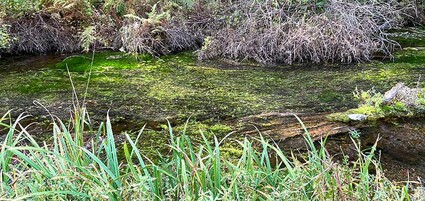Keeping an eye on the Metolius
Last updated 10/25/2022 at Noon

BILL BARTLETT
Local residents have expressed concerns about the condition of the Metolius River headwaters.
Readers of The Nugget have noted seemingly low flows at the headwaters of the Metolius River, one of Sisters Country’s most beloved and revered resources.
The latest reading by Oregon Department of Water Resources (ODWR) shows 55 CFS (cubic feet per second). In June of 2018 that was 102 CFS, followed a year later by a 95.6 reading, and last June it registered 74.
Kyle Gorman, ODWR regional manager in Bend, recalls his very first reading of the headwaters in 1991 when it logged in at 61 CFS. The stream, its source bubbling from underground springs, closely parallels water years, and the past three years have seen highly elevated drought throughout Central Oregon. So Gorman is not surprised by the measurements. He’s not alarmed, but concerned.
Earliest recordings are from 1972, when the flow was 133 CFS, so the long- term trend is deceleration. Old-time Camp Sherman locals partly blame the reduced flows on the growing numbers in our area.
“Drought is playing a large part, penetrating into the water table, but as the community grows we are drilling into the water table more and more and more,” Jeff Perin, the owner of The Fly Fisher’s Place in Sisters told the Deschutes River Conservancy.
The Nugget visited with resorts and RV parks along the river in Camp Sherman, and the source of all things Metolius: the Camp Sherman General Store. To a person, all agreed with Gorman’s assessment, but were quick to point out that such ebbs and flows are common.
Their clients, in large number anglers, have not said a word, as nobody fishes the headwaters. Indeed, a mile downstream from the source it’s good fishing, according to anglers we interviewed between the bridges.
Norm Kaufman of Bend said, “Streamflow seems normal and the water is clear.” Miles Milliken, his buddy, gave his assessment: “The hatches are really good, especially mayfly. Nymphing is really good.”
Last week’s ODFW (Oregon Department of Fish and Wildlife) report said, “The Metolius River continues to fish well. Streamers are a good bet for bull trout that are following kokanee on their spawning migration.”
Perin’s report from Saturday was bullish.
“Spent another day on the Metolius yesterday and had much better success than the last skunking I got. I got fish on Purple Comparaduns and PMD Film Critic and Tina got a couple on green drakes and Purple Comparaduns. There are a lot of PMDs, BWOs, caddis, Mahogany Duns going. Drakes are waning fast, but we saw some yesterday.
“Bull trout fishing has still been good and many people have seen bulls hunting down kokanee! Big Streamers are a must when we see that. Nymph action is excellent, with a lot of good euro nymph action, plus Oct Caddis Pupa, Golden Stones, Orange Pat’s Rubber Legs, eggs, and Rainbow Warriors.”
“While flows at the headwaters have fallen off, the height of the Metolius River has remained relatively stable,” Gorman said, reporting that at one gauging station north of Camp Sherman, the river had dropped just 0.2 of a foot from its usual height. Once you get to Lake Creek, roughly a half mile from the headwaters, the river looks full.
And, for the most part, it is. At Grandview, just before the Metolius enters the sprawling Lake Billy Chinook Three Rivers reservoir, flows Sunday were 1,260 CFS, off slightly from its 1,350 median.
Closer to Camp Sherman, at the Allingham Station reader, average flows for October run around 250 CFS. Since the drought it’s been closer to 200. This is consistent with nearly all the rivers in the basin, Gorman said.
Between the head and just below Lower Bridge, no fewer than seven year-round creeks flow into the Metolius — Lake, First, Jack, Canyon, Abbot, Candle, and Jefferson. Suttle Lake, as it drains out Lake Creek, provides a big portion of the water in the Metolius. Nearly two dozen high mountain lakes contribute to the pristine river.
Metolius derives from the Sahaptin word for “white fish,” referring to the light-colored Chinook salmon. The river is a sacred place for the Wasco, Warm Springs, and Northern Paiute of the Confederated Tribes of Warm Springs, who have hunted, gathered, and fished from the river for thousands of years.
Bart Wills, a geologist with the Deschutes National Forest, has written about the source: “With a 300-foot hydraulic gradient, the water passes beneath Black Butte and emits in two springs that come together to form the Metolius River, with a flow that ranges from 67 to 130 cubic feet per second. The discharge varies in response to precipitation and snowpack in the Cascade Range.”
At 29 miles, the Metolius is short, but its natural beauty and legendary fishing more than match its length. The river is protected by the National Wild and Scenic River Act of 1988 and Oregon’s Metolius Protection Act. In 2009, the Legislature designated the 448 square miles of the Metolius River basin as an Area of Statewide Concern arising from two proposed destination resorts in the basin. The legislation prohibits the development of residences, golf courses, and large resorts within the watershed.












Reader Comments(0)